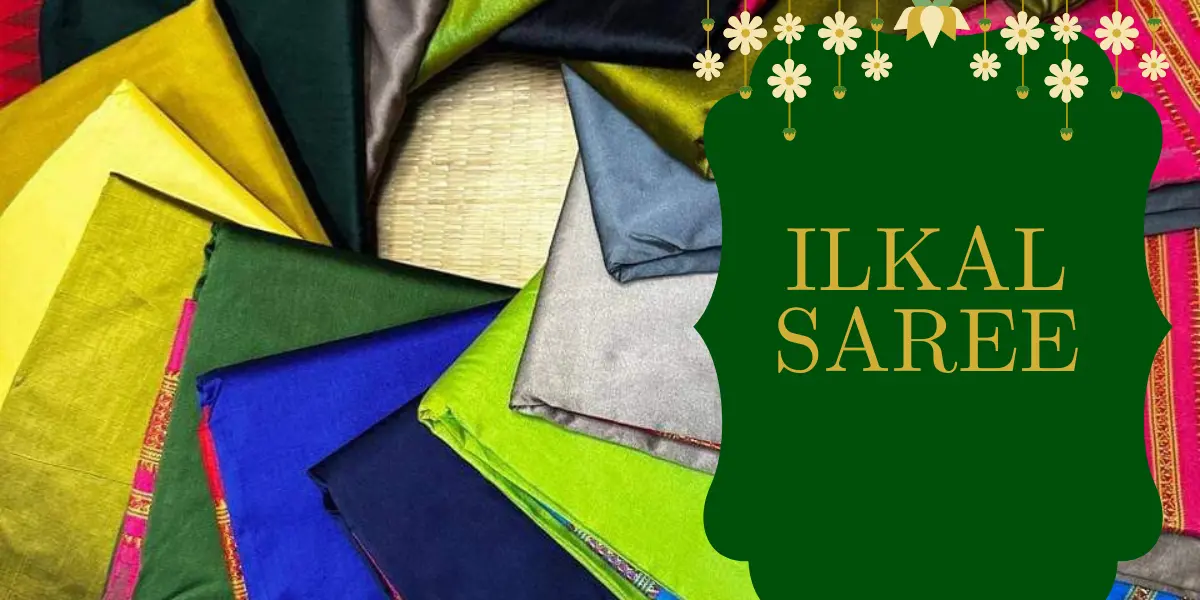Ilkal Saree: History, Origin & Features

Ilkal sarees, an epitome of grace and tradition, have carved a niche in the world of ethnic fashion. Originating from the small town of Ilkal in Karnataka, these sarees are a testament to the exquisite craftsmanship and rich cultural heritage of India. In this article, we delve into the intricate details of Ilkal saree, exploring their history, unique features, weaving techniques, and contemporary relevance.
History and Origin of Ilkal Saree
The legacy of Ilkal sarees dates back to the 8th century, with a history deeply intertwined with the cultural and economic life of Karnataka. The town of Ilkal, located in the Bagalkot district, has been a significant weaving center, where artisans have honed their skills over generations. These sarees are traditionally woven by the Devanga community, known for their expertise in textile weaving.
Distinctive Features of Ilkal Saree
Ilkal sarees are renowned for their unique blend of materials and distinctive patterns. The sarees are typically made from cotton, silk, or a mix of both, known as sico. The hallmark of an Ilkal saree is its traditional tope teni border and pallu, adorned with intricate designs and vibrant colors. The pallu often features red and white checks or temple motifs, adding to the saree’s allure.
Color Palette
The color palette of Ilkal sarees is a visual treat, dominated by rich reds, deep blues, vibrant yellows, and forest greens. These colors are achieved using natural dyes, ensuring that the sarees not only look beautiful but are also eco-friendly.
Material and Weaving Technique
The weaving technique of Ilkal sarees is a blend of cotton warp on the body and art silk warp on the borders and pallu. This combination results in a durable yet elegant fabric. The weaving process involves intricate steps, including warp tying, dyeing, and weft insertion, showcasing the meticulous effort of the weavers.
The Weaving Process
The making of an Ilkal saree is a labor-intensive process that requires immense skill and patience. The sarees are woven on pit looms, and the weavers follow a unique technique called kondiga, which involves joining the body warp with the pallu warp using a series of loops and knots. This technique ensures that the pallu remains strong and distinct.
Step-by-Step Weaving
- Warping: The process begins with preparing the warp threads, which are dyed in vibrant colors.
- Warp Tying: The dyed threads are then tied together to form the base of the saree.
- Weaving: The weft threads are inserted using a shuttle, creating intricate patterns and designs.
- Finishing: Once the weaving is complete, the saree is washed, starched, and ironed to give it a crisp finish.
Traditional and Contemporary Designs
Ilkal sarees are a perfect blend of tradition and modernity. While the traditional designs feature geometric patterns, temple motifs, and checks, contemporary versions incorporate floral designs and abstract patterns to cater to the tastes of the modern woman. The versatility of Ilkal sarees makes them suitable for various occasions, from festive celebrations to formal events.
Cultural Significance
Ilkal sarees hold immense cultural significance, especially in Karnataka. They are an integral part of traditional ceremonies and festivals, symbolizing prosperity and grace. The sarees are often passed down through generations, becoming treasured family heirlooms.
Festive Wear
During festivals like Ugadi and Diwali, Ilkal sarees are worn as a mark of tradition and celebration. The vibrant colors and intricate designs add to the festive spirit, making them a popular choice among women.
Bridal Attire
Ilkal sarees are also a preferred choice for bridal wear. The rich silk variants, with their intricate designs and luxurious feel, make for a stunning bridal ensemble. Brides often choose Ilkal sarees in auspicious colors like red and yellow, symbolizing marital bliss and prosperity.
Preservation of Craftsmanship
The art of weaving Ilkal sarees is a heritage craft that needs preservation. With the advent of machine-made textiles, the demand for handwoven sarees has seen a decline. However, efforts are being made to revive this traditional art form. Various government and non-government organizations are working towards promoting Ilkal sarees by providing support to the weavers and encouraging the younger generation to take up this craft.
Government Initiatives
The Karnataka Handloom Development Corporation has launched several schemes to support the weavers. These include subsidies, training programs, and market linkage initiatives to ensure that the weavers get fair prices for their products and access to a wider market.
Role of NGOs
Non-governmental organizations play a crucial role in preserving the craft. They conduct awareness campaigns, exhibitions, and fashion shows to promote Ilkal sarees. These initiatives help in creating a demand for handwoven sarees, ensuring that the weavers can sustain their livelihoods.
Buying and Caring for Ilkal Saree
When purchasing an Ilkal saree, it is essential to ensure its authenticity. Look for the GI (Geographical Indication) tag, which certifies that the saree is a genuine Ilkal product. Proper care is crucial to maintain the saree’s beauty and longevity.
Care Tips
- Washing: Hand wash the saree using a mild detergent. Avoid using harsh chemicals.
- Drying: Dry the saree in the shade to prevent the colors from fading.
- Storing: Store the saree in a cool, dry place. Use a muslin cloth to wrap the saree, preventing any damage from moisture.
Conclusion
Ilkal sarees are a testament to the rich cultural heritage and exquisite craftsmanship of Karnataka. These sarees, with their vibrant colors and intricate designs, are a symbol of timeless elegance. By supporting the artisans and promoting this traditional art form, we can ensure that the legacy of Ilkal sarees continues to thrive for generations to come.
Read our more Blogs…



Leave a Comment